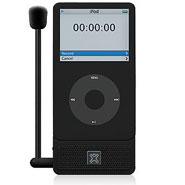Turns out that Apple likes to pirate other folks art…
Here’s an Apple ad and the Postal Service video they tried to get permission to use and then stole anyway when the band refused.
I’m guessing that they were inspired by Kuler, but they could have been first. I’m not sure. ColourLovers.com is extremely similar, create and share (and download!) color palettes. The ColourLovers folks did a couple smart things though, allowing you different types of downloads and also methods to embed palettes into your web pages.
No commentsFlektor demo from salon.com
What I like about these new web-based media tools isn’t just that they make it easier for normal people to do media editing, but they really show the power of Flash/Flex in a mind-blowing way.
No commentsSupa-editor
This kind of cut-up editing is old-hat for audio and has shown up in video as well from time-to-time, but this clip is a pretty awesome example to show what some kind of insane attention to detail can produce:
Creating a paypal button for Flex 2
I may post my source of this eventually, but for now I’m just wondering if there is a better way to do this. I spent a long time searching, but had zero luck. The existing mechanisms to integrate a paypal button into a flash site require the URLLoader class which doesn’t exist in AS3.
After spending a bunch of time searching the flex and paypal sites, I was getting really discouraged.
Finally, I came up with this hack:
I use the ExternalInterface to “shell out” to javascript where I create the form that paypal needs dynamically in Javascript and then submit it (also dynamically). It works, but it really seems like a hack to me.
Is there a better way to do this?
2 commentsNice little profile of Bjork’s musical technical director

Apple – Pro – Profiles – Alan Pollard
These Apple profiles are usually interesting reads, even if they are the web equivalent of infomercials. I’m always a fan of reading about some of the interesting setups that the big-time musicians use. Bjork’s set-up isn’t too goofy, but it is interesting that she is integrating the more abstract UIs from the various tools that her band is using to make the electronic stuff more compelling to her audience. Also, it must be nice to be able to borrow one of the two react-tables in extistance and then bring it on a tour.
No commentsFree kitchen percussion sample set
link: Welshs Synthesizer Cookbook: Analog Synthesizer Programming
Over 140 pots, pans, kettles, lids, bowls, containers and more
More unique than conventional drum samples
Multiple hits: bottoms, sides, rims with mallet and light stick
Recorded with a Marantz EC-335 split-stereo microphone
No commentsXTremeMac MicroMemo with iPod as field recorder
I’ve been waiting for years for a device that will let me use my iPod for field recording. Being able to record on a moment’s whim without buying a separate device or lugging my mini-disc or portable DAT around would be nice. I was jazzed when it was reveiled that the 5G iPod would record at CD Quality stereo and even more jazzed when I read the review of the micromemo on iPodLounge. I finally got one last week and I have to say I’m really disappointed. I mean, it is probably fine for recording voice memos, but without more settings options, it is useless with external mics.
 I did a little test with my two main, unobtrusive, field mics: a SoundPro SP-BMC3 dual-binaural setup, which is unpowered; and a Sony ECM-909A stereo mic that is self-powered. I also tried the included, mono, mic.
I did a little test with my two main, unobtrusive, field mics: a SoundPro SP-BMC3 dual-binaural setup, which is unpowered; and a Sony ECM-909A stereo mic that is self-powered. I also tried the included, mono, mic.
I did a little test sitting at my computer with Big Black playing at low volume in the background. I spoke into the mic and than just held it while the music played.
The results?
With the SoundPro: Silence, zero, zilch. XtremeMac says that you should use powered mics, so this isn’t completely a surprise, but I expected at least something. It does demonstrate how weak the attenuation is in the unit itself.
(linked files are the original WAV files produced with the recorder)
With the Sony powered Mic: Test with Sony Mic (3.4 MB) I was a bit underwhelmed here. Now, I wasn’t speaking in a “radio” voice. I was speaking somewhat sotto voce. I’m not bootlegging bands, I’m trying to capture ambiences. The sound of a market or church bells in the distance. I’ve often used this mic with my minidisc to do just that. There isn’t enough power in this Micromemo for this at all. You can barely hear the music coming out of the speakers less than two feet away from the mic.
With the included Mic: XTremeMac MicroMemo test with included mic (2.1 MB) The relative attenuation here is surprising. The included mic has a third ring around the jack, which I’m assuming is for supplying power. There is a lot of noise with the included mic, but it is also much brighter than my trusted Sony.
I didn’t bother using an extra booster inline with the mic because that defeats the whole purpose for me.
The gist? The MicroMemo is fine for recording memos. It doesn’t have enough power to do field or location recording, so I wouldn’t bother. I might carry it around in case I come across an interesting sounding construction site, but for Pike Place Market or down by the waterfront, I’ll continue to bring the mini disc.
[addendum: just saw Robin Hamman’s review. Sounds like he is in complete agreement]
2 commentsDrew Keller on NAB
Interesting take on NAB from a video editor/Windows Media team member. Nice, homey, take on the NAB experience.
http://drewkeller.vox.com/library/post/nab-2007.html
No commentsMap design
Map design is fascinating. It is one of the highest forms of information design. How to convey complex information so that it is instantly accessible. The map showing Napolean’s foray into Russia in Edward Tufte’s books where he plots the size of the the army vs their penetration into the country is a classic example.
Subway and bus maps are especially interesting because they have to serve multiple purposes: they have to be legible from a distance (across a crowded subway car), they have to convey data quickly (should I get off here or is the next stop closer to where I want to go) and they have to be useful to locals, who know their geography and tourists who may not know where they are immediately.
Eddie Jabbour of Kick Design has redesigned the NYC subway map. His new map is clearer and easier to parse visually, but he has abandoned spatial continuity. The comparisons on his site between the old and new are obvious and even if you don’t like his proposed map, the design is instructive.


